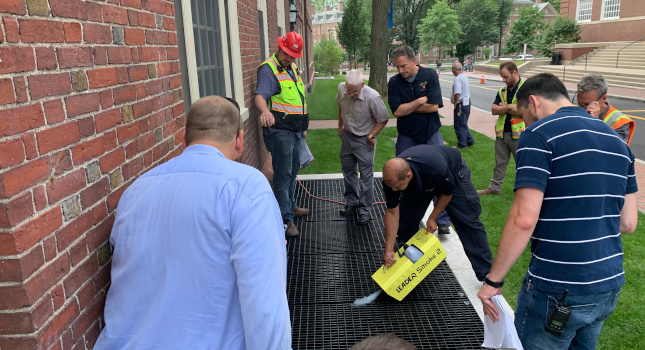Integrated systems testing incorporates multiple related systems, rather than a single piece of equipment or a single system

Learning Objectives
- Understand the importance of integrated systems testing within the commissioning process.
- Identify the commissioning provider’s role in leading IST best practices.
- Recognize the owner and facility maintenance staff roles in the IST process.
This article continues a series of excerpts from the AABC Commissioning Group’s forthcoming ACG Building Systems Commissioning Guideline: Best Practices for Independent Third-Party Commissioning Providers. For more information, see the first article by clicking here.
Integrated systems testing is a version of — and an extension to — functional performance testing where the IST incorporates multiple related systems, rather than a single piece of equipment or a single system. An IST is approached in the same manner that the commissioning provider directs, witnesses and documents functional performance tests.

The integration of the individual equipment and systems is the final test of what has been designed, procured, installed, programmed and functionally tested to prove the performance required by codes and standards; the design and expected by the owner’s project requirements. The integrated system tests are critical to the overall approach to the commissioning process as they prove the integration of equipment, controls and systems into combined operation which will represent the actual functionality of the facility.
While developing the commissioning scope of work, the commissioning provider should verify the expected ISTs that will be required with the owner. In many cases, the commissioning provider should use their experience and typical industry requirements to recommend ISTs to the owner if a comprehensive listing is not provided.

Typical integrated systems testing includes, but is not limited to:
- Entire facility integrated test.
- “Pull-the-plug”/black site emergency power systems test.
- Fire alarm/fire suppression (Note: NFPA defines IST requirements relative to these systems).
- Chilled water system.
- Heating water/steam system.
- Storm avoidance/islanding.
- Security emergency/active shooter.
- Code blue/infant abduction systems.

During the development of IST procedures, the commissioning provider should review all of the components and systems that will interact in a particular situation or modification in operations. For example, consider the “pull-the-plug” or black site emergency systems test. This test simulates loss of utility services to a facility and the resulting reactions and interactions of the systems within the facility to this situation.
The reactions can include performance of emergency and critical electrical power systems, transition to on-site water and/or sewage services, reaction of people movers such as elevators and performance of equipment that may have specific shut down or transition protocols in the event of a loss of utility services. To be comprehensive, the IST developed must consider the detailed operations of all systems that interact under the test scenario.
Once the IST is developed, it is the responsibility of the entire project team to review and understand the expected interactions of the systems for the given set of circumstances. The review of the IST should include the design team, construction manager, installing contractors and the owner. Each party is responsible to confirm that the actions and reactions identified as expected results of each step within the IST are what is expected for “real world” operations and meet the relevant code requirements, as well as confirming they are within the capabilities of the equipment and systems as installed.

Integrated system testing best practices
Many of the best practices are the same as for functional performance testing but take on added importance when considering the testing of the entire system as it was intended to operate. Recommended best practices to consider in developing and executing ISTs include:
- Coordinate with the owner to identify ISTs in pre-design or as soon as brought into the project.
- Include successful completion of IST(s) in the requirements for substantial completion and turnover.
- Identify during design phase the required information for system interactions.
- Include a listing of expected ISTs in the construction documents.
- Review the listing of expected ISTs with the project team during the construction phase commissioning kick-off meeting.
- Maintain the IST(s) as a specific item(s) in the master project schedule.
- Develop the IST(s) with a holistic consideration of all possible system interactions given a specific set of circumstances including systems that may not be within the commissioning scope of work. The commissioning provider that is developing each IST should be sufficiently knowledgeable of the systems and equipment involved and be familiar with the design, the OPR and expected operations of the systems and equipment.
- Write the IST(s) in a format that is repeatable by the facility management staff or a future re-commissioning program.
- Complete development of the ISTs shortly after completion of the submittal process to allow adequate time for review by the project team.
- Review the IST procedures and expected system interactions with the project team including contractors and designers when developed. Be aware that updating of systems and programming to meet the expected and required results may be mandatory and will take time.
- Encourage contractors to perform their own pretests before the actual IST.
- Encourage participation of the facility management staff as this is their chance to see how the entire system performs before it is under their responsibility.
- Identify roles and responsibilities for each party during the IST including who will be witnessing interactions of systems at separate locations, as appropriate.
- Lead a pre-IST review session with the project team to verify understanding of the expected roles and activities during each step of the IST.
- Record detailed notes on each of the expected (and unexpected) system interactions during the steps of the IST.
- If a step of the IST fails, stop the IST and return to “normal”/pretest conditions then repeat the entire test once the issues are resolved.
- Compile all information from the IST(s) into the commissioning report and the systems manual.
Because integrated system testing is not able to be performed until individual system or component installation is complete and final, this is often one of the last activities of the construction acceptance phase. The entire project team should understand that these tests are the final dress rehearsal for the systems immediately before achieving substantial completion and turnover to the owner for beneficial use.
ACG is a CFE Media content partner.


